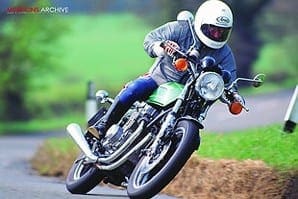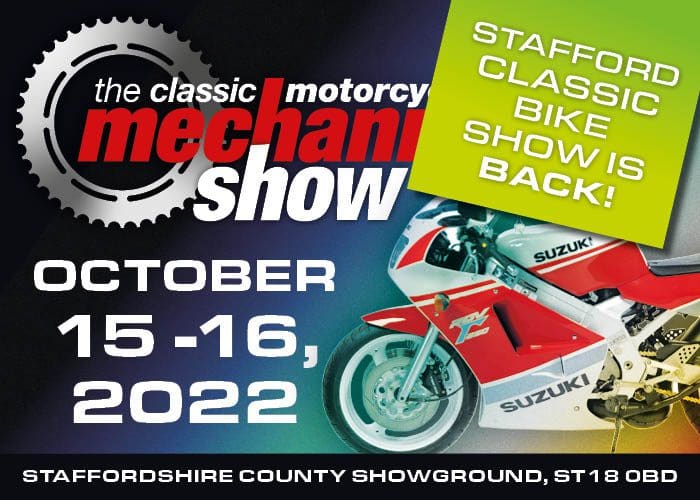
It’s generally agreed that Japanese motorcycle engines have a short shelf life, if not short fuses. Few are produced for more than five years without being updated or replaced, and even Honda’s original CB750 barely lasted a decade before being superseded.
So any Japanese machine with a design that has lasted 30 years has to be something of a phenomenon. Honda’s 700cc V-twin Deauville tourer’s history can be traced back to the early 1980s, but that’s got an engine which has been offered in a number of forms, from the 400cc NT400J in Japan, through the 500cc shaft-drive VT500E and the Dakar-styled 750cc Africa Twin.
So what about an engine that was launched in 1976 and was used, more or less unchanged, until emissions laws forced its demise some 30 years later? May I present to you the Kawasaki Z650 and its derivatives, which were revived in the 21st century as the bargain 750cc ZR7. That’s pretty remarkable, and even though I’m aware that Kawasaki has been making police bikes in the US for almost as long, I reckon it must be a record.
But then the Z650 was pretty remarkable even when it first appeared. Compact and muscle-bound, it could run rings around the 750cc fours of the day and was almost as quick as Suzuki’s 124mph GS750, which appeared the same year.
 Kawasaki used it as the base of a series of machines, with an updated 650 that led to a 750 that predated the GPz750 series, including the 112bhp ZX750 Turbo (showing the sort of power it could accommodate), until the factory started focusing on its liquid-cooled fours in 1984. It was revived twice: first as the 750 Zephyr in the 1990s and 10 years later as the ZR750, proving its resilience. Power increased along with handling improvements, but the same engine – a conventional double-overhead camshaft four with two valves per cylinder and five speeds – prevailed. It worked then and still works well now, providing a robust base for all manner of tuning options.
Kawasaki used it as the base of a series of machines, with an updated 650 that led to a 750 that predated the GPz750 series, including the 112bhp ZX750 Turbo (showing the sort of power it could accommodate), until the factory started focusing on its liquid-cooled fours in 1984. It was revived twice: first as the 750 Zephyr in the 1990s and 10 years later as the ZR750, proving its resilience. Power increased along with handling improvements, but the same engine – a conventional double-overhead camshaft four with two valves per cylinder and five speeds – prevailed. It worked then and still works well now, providing a robust base for all manner of tuning options.
Potent, compact and durable, the original Z650 was more than just a smaller version of the 903cc Kawasaki Z1 launched four years earlier. It was a chance for project design chief Gyoichi ‘Ben’ Inamura – father of the Z1 – to show that the factory could produce both fast and agile four-stroke motorcycles.
Kawasaki’s master stroke with the Z650 engine was to combine a modern, for the time, bottom end with a high-performance cylinder head. While the 903cc Z1 engine used a fabricated crankshaft with roller main and big end bearings, plus a gear primary drive, a strong design that was expensive to make, Inamura took a leaf out of Honda’s book and used a crankshaft and drive system similar to that used on the CB500 Four. This had a one-piece forged crankshaft with plain big-end and main bearings, the drive being taken from the centre with an inverted-tooth chain to a countershaft from which spur gears connected with the clutch on the gearbox mainshaft. It was easier and cheaper to manufacture without any real loss in durability.
Inamura then topped the crankcases off with a cylinder head featuring double overhead camshafts that opened the valves directly through bucket-type followers.
 The Z650 set a new performance standard and with a maximum 64bhp on tap at 8500rpm produced the highest power per litre (98bhp) of any 500cc-plus bike yet offered for road use.
The Z650 set a new performance standard and with a maximum 64bhp on tap at 8500rpm produced the highest power per litre (98bhp) of any 500cc-plus bike yet offered for road use.
As air-cooled engines go it was compact, with a bore and stroke of 62 x 54mm, single inlet and exhaust valves and a quartet of 24mm Mikuni carburettors. The combustion chamber design enabled a compression ratio of 9.5 to 1 but the engine ran reliably on unleaded fuel. Solid-state electronics were still in their infancy at the time, so the ignition used traditional coils and contact breakers.
There was nothing earth-shattering about the chassis. The wheels had wire spoked steel rims with 3.25 x 19 and 4.00 x 18 Japanese Dunlop tyres. But it was shorter than normal with a 56.5 in wheelbase which might have provoked waywardness in previous Japanese machines except that this one came with a well-braced duplex tubular steel frame, a lower seat height and steering geometry (63 degree rake and 4.25in trail) that provided both neutral steering and stability at speed.
Kawasaki was proud of the Z650, so in a first for a Japanese factory it invited the press to a special launch. Venue was the racing circuit at Ingliston in Scotland and roads in the surrounding wild countryside. The short track proved to be ideal for the bike which with a combination of snappy acceleration and good cornering clearance showed that good handling was no longer the preserve of British or Italian bikes. Some wanted stiffer suspension but as we found on the country roads, the Z650 was pretty well balanced for everyday sporting use.
Notes made during the following road test sum up my conclusions: 'You can skim through bends much more confidently than the Z900 or Z1000 would ever allow, and with none of the gut-churning high-speed wobbles that still mark the Z1000 as a bike to be respected when the going gets hot.'
'You can skim through bends much more confidently than the Z900 or Z1000 would ever allow, and with none of the gut-churning high-speed wobbles that still mark the Z1000 as a bike to be respected when the going gets hot.'
If there were any doubts that the 650 could mix it with bigger 750cc machines in a straight line they were firmly silenced the following March when at Daytona Beach, a few days after Speed Week, Kawasaki launched an attack on the world 750cc long-distance speed records with a brace of mildly-tuned machines.
Superbike racer Steve McLaughlin was one of the six-strong team of riders that also included Cycle magazine editor and racer Cook Neilson, and fellow racers Wes Cooley, Keith Code, Walt Fulton jnr and Randy Cleek.
As Steve recalls, the Z650s were punched out to around 720cc and were fitted with top fairings. Kawasaki also ran a 750cc two-stroke triple, on which Steve clocked 154mph over 10km.
“It was really neat on the 650s,” said Steve, “at night they’d put reflectors on the track to guide us around the bowl. Cook took the 100km record and I think the FIM credited me with three records.”
 Kawasaki came away with a string of records that would have done credit to a much bigger bike, let alone a 650. The highest speed was for the FIM/AMA (American Motorcyclists Association) 100-km record at 133.6mph, followed by the FIM 1000km at 127.89mph and the AMA/FIM six-hours at 127.7mph. Proving the bike’s durability, another team ran one of the 650s for 24 hours round Daytona’s speed bowl at a record average of 117.05mph.
Kawasaki came away with a string of records that would have done credit to a much bigger bike, let alone a 650. The highest speed was for the FIM/AMA (American Motorcyclists Association) 100-km record at 133.6mph, followed by the FIM 1000km at 127.89mph and the AMA/FIM six-hours at 127.7mph. Proving the bike’s durability, another team ran one of the 650s for 24 hours round Daytona’s speed bowl at a record average of 117.05mph.
Back home with a test bike, the Z650 surprised us with its nimble handling, but the bike’s straight line speed came as a real shock. On the road, it demonstrated crisp throttle response and real urge through the gears, pulling hard from 4000rpm and screaming through to beyond the 9000rpm redline. It was pretty smooth too, particularly at 5500rpm which corresponded conveniently with a 70mph road speed. I liked the natural riding position and the swept-back bend of the grips: you felt ready for action.
Acceleration for passing traffic was a breeze: snick down a gear and with a snap of the wrist the bike lunged ahead. It was a real hot rod. And yet this was otherwise a conventional motorcycle with a traditional chassis and wire-spoke wheels. Only clue to its parentage was the dodgy front disc brake that was only marginal in the wet.
'At MIRA’s timing straight the performance figures showed that the Z650 was one of the quickest-accelerating machines we’d ever tested at Motor Cycle, the weekly paper'
At MIRA’s timing straight the performance figures showed that the Z650 was one of the quickest-accelerating machines we’d ever tested at Motor Cycle, the weekly paper. It clocked 12.9 seconds through the standing quarter mile with a terminal speed of 101.9mph, very close to the Suzuki GS750’s 13.2 seconds and 103.5mph.
Up to 70mph, the Z650 could accelerate almost as quickly as the Kawasaki Z1, on which through the quarter mile I’d clocked 12.55s at 107.55mph three years earlier. From a standstill to 110 yards, the 650 reached 66.8mph in 4.5 seconds, only a few clicks behind the Z1’s speed of 68mph.
While the Z650’s strong power and lean tanked-up weight of 495 pounds helped, its low gearing gave it an edge, the engine revving to just over 9000rpm in fourth as it tripped the lights in the quarter mile.
But that didn’t dent its top speed. In a racing crouch I clocked a mean two-way maximum of 119.6mph, the engine revving smoothly to 9500rpm in top, way over the 8500rpm peak power revs quoted by Kawasaki.
Nor did the performance have any real impact on fuel consumption. Used around town it recorded 52mpg and an overall average of 46.5mpg, giving a range of up to 160 miles.
 Kawasaki went on to improve the Z650 with cast-alloy wheels, CV carbs with a lighter twist-grip action, needle-roller swing arm bearings, an automatic cam chain tensioner and a two-phase alternator. In 1979 it fitted ‘all-weather’ sintered brake pads.
Kawasaki went on to improve the Z650 with cast-alloy wheels, CV carbs with a lighter twist-grip action, needle-roller swing arm bearings, an automatic cam chain tensioner and a two-phase alternator. In 1979 it fitted ‘all-weather’ sintered brake pads.
But what we really wanted was the 750cc version, which was launched as the Z750E in 1980, a bike that really was expected to cut it with the heavyweights.
Capacity was upped to 738cc by opening up the bore diameters to 66mm, which along with the quartet of 34mm CV Mikuni carbs gave a claimed peak power of 74bhp at 9000rpm.
The slightly higher state of tune – giving 100bhp per litre – came from larger inlet and exhaust valves and longer opening periods, but the Z750E’s peak power still fell short of Honda’s CB750F with 79bhp and Suzuki’s GSX750 with 80bhp.
But what really scored with the Z750E was that it was actually smaller, lower and lighter than the 650, and tiny compared with the competition, both of which were derived from 900cc and 1100cc machines.
With a 55.9-inch wheelbase the Z750E was two inches shorter than the 650 and at 463 pounds dry, two pounds lighter. If the 650 was agile then the 750 was even more nimble. This was helped by a lower seat which was no less comfortable than the 650s because the frame tubes below it had also been lowered.
It was as if a new test rider had taken over development, one who was six inches shorter and a stone lighter than the 650s. Clue to this was the softer suspension, which also featured a telescopic fork with air-pressure adjusters and rear shocks with four rebound damping levels, adjusted with a knurled alloy ring at the top of the body.
Despite the softer ride, it could still be cranked over aggressively thanks to the generous cornering clearance, the footpeg ends being first to touch just as you were running off the edges of the predictably grippy Dunlop tubed tyres.
I’m a sucker for smaller, wieldier bikes, but in the Z750E’s case some taller riders complained that it was just too cramped with a short footpeg-to-seat measurement of just 18 inches. That’s tight for an all rounder.
Throttle response  and power delivery were much like the 650, only more so with a crisp and flexible pull all the way to the redline at 9500rpm. Only flaw was an annoying snatchiness off idle. Although smoother than the Honda CB750F, the Z750E felt rougher than the smaller 650. Enough vibration was transmitted through the handlebar to the mirrors to blur the rear view images enough to make you think twice about the speed you could so easily enjoy.
and power delivery were much like the 650, only more so with a crisp and flexible pull all the way to the redline at 9500rpm. Only flaw was an annoying snatchiness off idle. Although smoother than the Honda CB750F, the Z750E felt rougher than the smaller 650. Enough vibration was transmitted through the handlebar to the mirrors to blur the rear view images enough to make you think twice about the speed you could so easily enjoy.
Gearing was higher than the 650s, as you’d expect given the need to cater for the extra power. The sprockets were changed to accept a tougher O-ring 630 chain, using a 33/13 ratio (the 650 used 42/16) that with such a small engine sprocket was bound to generate extra vibration.
Strangely though, although the gearing gave 120mph at 9000rpm we couldn’t get much more. At the time, Which Bike? magazine didn’t have access to MIRA, so we hired Brands Hatch for a few hours and did our best to wring the Kawasaki’s neck. But the highest speed we obtained was just 122mph. I have to confess that the acceleration estimates were seat of the pants, but 12.5 seconds for a quarter mile was reasonable. Fuel consumption was more or less the same as the 650s: between 44.3 and 46.9mpg.
After a modest restyling for 1981 with a larger capacity and more angular fuel tank with the Z750L, the next stage in the hopping-up of the Ben Inamura’s engine came with the GPz750, the third of Kawasaki’s new sports range to appear after the GPz550 and GPz1100 models.
Appearing for the 1982 model year, the GPz750 came in the factory’s hallmark red bodywork and all-black engine and exhaust system, topped off with a nose fairing that enclosed asset of electronically-driven instruments, either side of which slightly upswept bars carried clunky hand controls.
To raise the power to 80bhp, compression was raised from 9 to 9.5 to 1, the combustion chambers reshaped, the valve opening quickened and along with smoothed intake ports the 34mm Keihin carburettors were replaced with less restrictive Mikuni items featuring cold start jets rather than choke flaps. Oil jets in the connecting rods sprayed the undersides of the pistons and an oil radiator kept temperatures under control.
 Other down sides were an increase in weight of 13 pounds to 512 pounds with a tankful of fuel and a lengthening of the wheelbase to 57.5 inches.
Other down sides were an increase in weight of 13 pounds to 512 pounds with a tankful of fuel and a lengthening of the wheelbase to 57.5 inches.
I tested the bike at the end of 1982 and by the time I’d finished with it the odometer showed more than 9000 miles so in a sense it could be regarded as a more meaningful exercise. Certainly the bike showed how it could cope with more inclement weather, which wasn’t very well, with the exhaust system looking shabby and the wheels really difficult to keep clean.
In theory, the GPz750 should have had the legs of the Z750L with sharper handling but it felt awkward and top heavy by comparison.
Neither was it that quick. At MIRA, and using the same gearing as the Z750E, it clocked a best one way speed of 126.2mph but the mean top speed was just 121.5mph and well short of peak revs in top gear. On the face of it that’s not too bad, but Kawasaki’s own softly tuned shaft-drive touring version of the 750, the Z750GT, managed to clock a mean two way figure of 127.2mph when I had tested it seven months earlier in the year.
With power more concentrated at the top end of the rev range, the GPz750 dispatched the quarter mile in a mean 12.63 seconds with a terminal of 103.8mph, only slightly better than the Z650 and the shaft GT. It should have done much better. Perhaps it was just tired.
Kawasaki revised the GPz range again for 1983, the most obvious change to the 750 being the use of frame-mounted and more slippery fairing and a longer chassis with Uni-track rear suspension featuring a single shock with a coil spring augmented by air pressure.
Power was increased again, this time to a peak of 86bhp at 9500rpm. Most of the components were the same as on the Z750E except that the inlet camshaft timing was lengthened again from 270 degrees to 286 degrees, the pistons used a special surface treatment to better dissipate heat and the electronic ignition first adopted on the Z750E now also came with electronic advancing as well.
A longer 58.7in wheelbase and revised steering geometry (63.5 degrees head angle rather than 63 degrees) with an 18in wheel using a wider tyre (matching the rear) provided better stability as well.
As might be expected, the GPz750's higher state of tune forced a sacrifice in flexibility and it was noticeably less potent below 6000rpm, but for banzai motorway blasts the bike would rush through the gear to 10,000rpm smoothly thanks to the engine’s front rubber mounts while the fairing enabled a flat out speed of 125mph on the clock in comfort, making 100mph a breeze.
The performance testing at MIRA confirmed this, with a prone top speed of 128.5mph and a best one way speed of 131.6mph.
 A slight trimming in overall weight to 501 pound also helped improve acceleration with the standing quarter mile time being cut to 12.38 seconds with a terminal of 107.6mph. But for all the tuning and improvements the writing was on the wall for the Kawasaki, because Honda’s VF750F, a modern liquid-cooled vee-four was much faster with a 130mph plus top speed and a quarter mile time of 12.09 seconds that made the Kawasaki seem slow.
A slight trimming in overall weight to 501 pound also helped improve acceleration with the standing quarter mile time being cut to 12.38 seconds with a terminal of 107.6mph. But for all the tuning and improvements the writing was on the wall for the Kawasaki, because Honda’s VF750F, a modern liquid-cooled vee-four was much faster with a 130mph plus top speed and a quarter mile time of 12.09 seconds that made the Kawasaki seem slow.
But Kawasaki’s engineers already had plans for something new, the first clue to which had been the liquid-cooled 16-valve GPz600R which appeared the same year as the GPz750 Uni-trak, although the air-cooled GPz continued for a few years later.
For 1984, Kawasaki launched the liquid-cooled 16-valve GPz900R along with a 750cc version for the Japanese domestic market, both of which offered dramatically better performance.
The air-cooled 750cc four wasn’t forgotten. In its less frenetic state of tune it provided the power for the 750cc model in the Zephyr retro-style range in 1991 and continued with the ZR7 after the Millennium.
For undiluted fun, the simple pleasures offered by the later 650cc and early 750cc fours are indisputable: find a clean one and it will respond well to modification with modern exhaust systems, ignitions and carburettor set ups. Not so much the Mean but the Dream machine. ![]()












